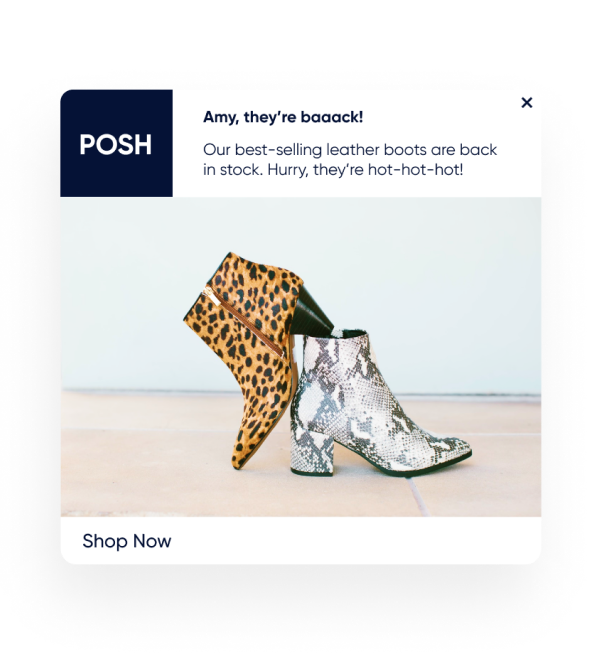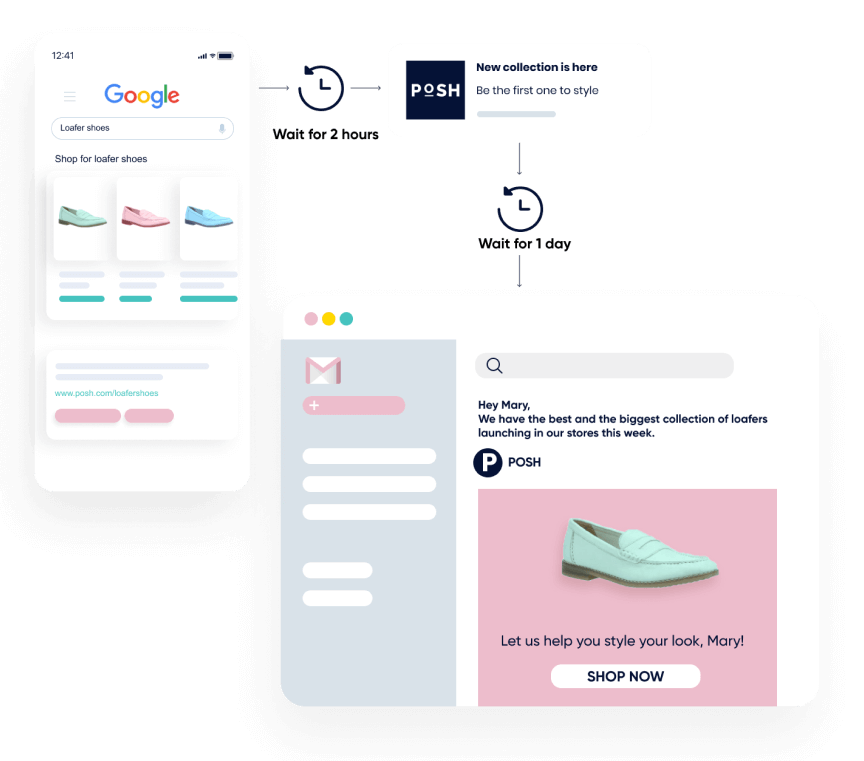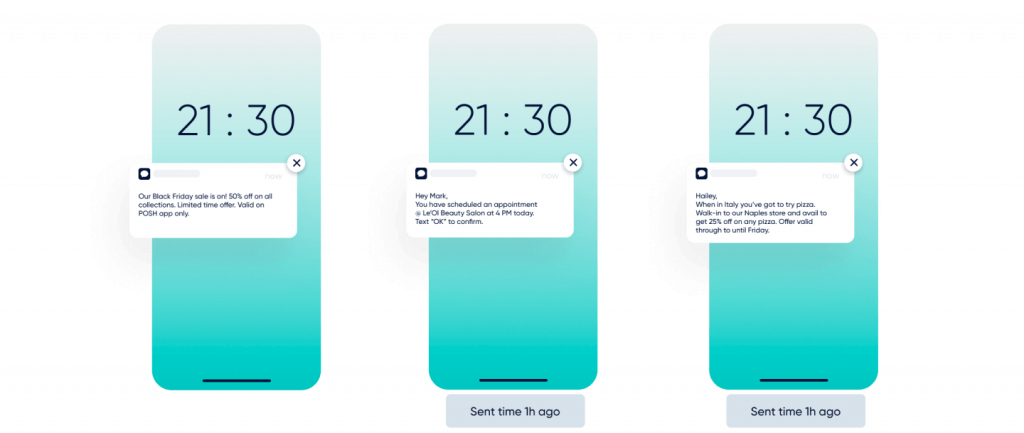5 essential steps to effortlessly switching messaging platforms
Perhaps you’ve been struggling to hit your KPIs using your current messaging provider, or you can’t prove the ROI to your C-suite. Whatever your struggle, a good messaging provider can transform your marketing efforts. It can boost conversions and average order value, increase customer loyalty, and make marketing the poster child for efficient revenue generation in your organization.
Updated on 10 Oct 2025
Before you jump to a new provider, take some time to consider the most important factors. Otherwise, you’ll end up exchanging one set of challenges for another. This blog sets out a five-step process for seamlessly moving to a new messaging provider.
It’s 7:20 am, and you jump out of the shower, shampoo and all, to check the SMS notification you just received. This could be urgent: you’ve been waiting to hear from your dream job about the next stages of an interview.
You grab the phone to check your messages… the SMS turns out to be from a clothing brand telling you about their latest sale. Fuming, you vow never to buy from that brand again.
No brand can ever be certain of the right time to message its customers. But there are lots of wrong times—and lots of wrong messages.
While keeping customers updated is the lifeblood of many eCommerce brands, you’ve got to be relevant, timely, and engaging. Bad messaging can be worse than no messaging at all.

Step 1: Work out what problems you need to solve
Whenever you’re thinking of making a change, make sure your emotions don’t get the better of you. Get your team together in front of a whiteboard (or over Zoom) and discuss the issues.
- What, exactly, is wrong with the messaging provider you’re using?
- What are your pain points?
- What limitations does it have that make you want to tear out your hair?
Perhaps there’s not enough automation and setting up campaigns takes you too long. Or maybe the platform doesn’t integrate with enough of your tech stack, and you have to re-input customer data every time you use it.
Whatever the reasons, list out everything and then try to rate the challenges on a scale of 1-10, with 10 being the most difficult.
If your message engagement is low, you can also survey your customers to identify any issues on their end.
- Are the messages relevant?
- Are they being sent at the right times?
- Are they even receiving messages?
You might also want to survey your customers to uncover or reiterate their preferences.
- Which channels do they prefer?
- What kinds of messages do they want to receive?
- What times do they prefer you to contact them?
Once you’ve compiled a list of issues and customer preferences—and rated them in order of importance—you can move on to step two.
⭐⭐⭐⭐⭐
“Switching to Insider as our messaging provider was a game-changer. Since migrating to their platform, our Web Push click-through rates have surged by 20%. Insider’s personalized and targeted approach revolutionized our customer engagement and has driven significant growth in sales and increased customer loyalty.”
– VP of Marketing | Global fashion brand
Step 2: Make a shopping list
Now you know the problems you need to solve and the customer preferences you need to satisfy, it’s time to research messaging providers to find the one that best fits your needs.
Many people when discussing messaging providers think only of SMS messaging providers and switching SMS marketing platforms. But any good marketer knows you need to reach your customers across multiple channels.
So again, think about your customer preferences as well as what works for the products you sell, and consider the full range of channel options:
- SMS
Benefits: High open rates, high response rates, and lightning-fast delivery.
- Push notifications
Benefits: Good for urgent and timely updates, showcasing new relevant content, and reducing cart abandonment rates.
Benefits: High engagement, high retention rates, and good for personalization.
Benefits: High ROI, great for relationship-building, and lots of functionality and providers to choose from.
The best marketers and most successful eCommerce brands increasingly turn to omnichannel communications. Omnichannel is all about putting customer experience at the center of your operation. It takes the best from a multichannel strategy and leverages technology to deliver a consistent and seamless customer experience while simplifying your operation.

When researching omnichannel providers, look for essential features, including:
- Scalability: Can it give you the capacity you need as your market and customer base expands?
- Reliability: Is it always there for you when you need it in terms of performance?
- Analytics: Can it analyze all your campaigns and results as needed?
- Data security: Does it keep your customer data secure? Is it compliant with data protection laws in all the markets in which you want to operate?
- Personalization options: To what extent can you personalize your messaging?
Step 3: Get the transition right
Transitioning to a new martech provider can be tricky and doesn’t always go to plan or to budget. You can reduce the risks and increase the chances of success by following a proven methodology.
Start by setting clear goals and defining clear timelines with key milestones. As award-winning digital transformation expert, Umur Korkut, puts it: “You must take the time to set clear goals during the onboarding process. This enables you to track progress effectively. And helps to accelerate the realization of those objectives.”
So, to summarize the key steps:
- Define clear implementation goals with your team
- Verify those goals in consolidation with other teams in your organization
- Consult with your messaging provider to devise realistic timescales with measurable milestones along the way
- Leverage your provider’s expertise
- Encourage feedback during the process
Having reviewed best practices, let’s now dive into the specific, actionable steps you can take as a brand to reduce your time-to-value.
⭐⭐⭐⭐⭐
“Migrating to a new messaging provider felt daunting, but the Insider team made the whole process seamless, and our decision to switch paid off immensely. Insider’s advanced AI algorithms and personalized messaging transformed our customer interactions, leading to higher conversions, engagement, and ultimately, revenue.”
– VP of eCommerce | European supermarket chain
Step 4: Ensure a seamless user experience
Migrating user data and preferences between platforms is where things are most likely to go wrong. Common issues include data loss or corruption, or the data not being high enough quality in the first place. This is why it makes sense to look into using a customer data platform (CDP) such as Insider’s.
Why? Because a quality CDP unifies your customer data across all your customer data points and systems. Do you have customer data in Salesforce? No problem—Insider’s CDP can integrate with Salesforce and link all that data with customer data from your other systems.
No more silos. No more manual data re-inputting or wasted time.
To migrate data and ensure your users get the optimum experience, it’s best to follow the expert advice of your platform’s support team. Make sure to also communicate your concerns and ask any questions you might have with your platform provider.
At Insider, we have a dedicated support team to help with the transition, including the migration process.
Make sure also to test your new messaging system in a controlled environment before you go live and roll it out for all your customers. Better to uncover unexpected problems before they affect your entire customer base.
Step 5: Optimize, optimize, optimize
Once your new system is up and running, you want to continually optimize it. Set clear KPIs around your messaging service and track them.
- Which ones are you smashing?
- Which are you struggling to hit?
- What obstacles are in the way and how can you overcome them?
Talk to your provider about ways they might be able to help or look into other features in the platform that may help to solve these challenges for you. You can’t improve what you don’t measure, so work out your KPIs, work with your provider to achieve them, and suggest new or improved features where needed. A good provider will be only too happy to oblige and help you hit your goals.

Don’t plan to fail
When it comes to making any martech change, those who fail to plan plan to fail, as the old adage has it. Work out what you really need from your messaging provider and then carry out as much research as you need to be confident of your choice.
Some people find it useful to put together a pitch for the top providers they’re considering as if making the case for investment to the C-suite.
There are huge potential benefits to changing providers, and there are many providers that can do a good job for you—just make sure you’re clear on what you need.
Are you looking to switch messaging providers?
Hopefully, this blog has helped clarify your key considerations for making the switch.
If so, book a demo with one of our customer success experts to discover why Insider is the top messaging provider for thousands of global brands.
Closing thoughts
A business is always evolving, and so are its goals. To run a successful relationship with SaaS platform stakeholders, it’s also important to have a clear understanding of the vendor’s product roadmap and upcoming releases and to align your goals with the vendor’s product roadmap. Additionally, regular communication and transparency about usage and feedback are crucial, as well as having a clear follow-up plan to ensure the discussed points are being addressed and the customer’s objectives are met.
Business Reviews help keep a track of gaps, incorporate a plan to achieve new goals in real-time, and stay on top of your business growth plan. It helps all parties involved to tap the full potential of the association and presents an opportunity to collaborate, learn from each other, and grow the business together as a team.



















